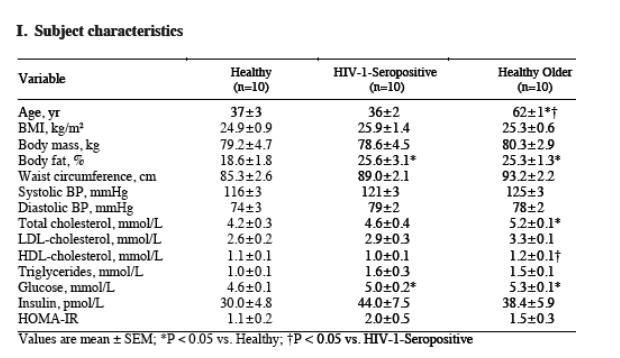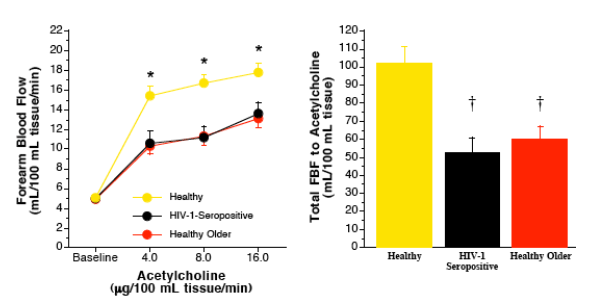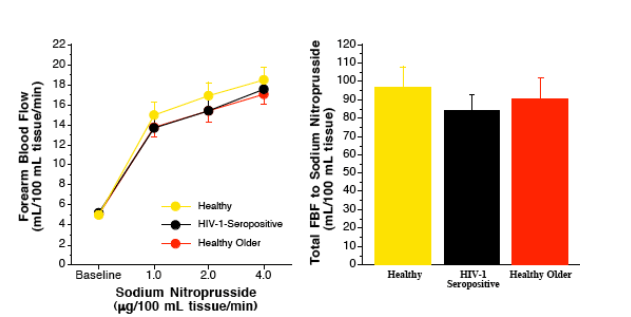 |
 |
 |
| |
HIV-1 INFECTION IS ASSOCIATED WITH ACCELERATED VASCULAR AGING
|
| |
| |
Reported by Jules Levin
CROI Feb 8-12 2009 Montreal
AUTHOR CONCLUSIONS
The results of the present study demonstrate that endothelium-dependent vasodilation is impaired in HIV-1-seropositive treatment naive men compared with healthy men of similar age.
The degree of impairment in endothelial vasodilation in the HIV-1-seropositive men was similar to that of healthy men 25 years older, suggesting that HIV-1 infection is associated with accelerated vascular aging.
Diminished endothelial-dependent vasodilator function may contribute to the greater risk of cardiovascular disease and adverse vascular events in HIV-1-seropositive adults under the age of 50 years.
Background: Cardiovascular disease (CVD) and acute vascular events often
occur in HIV-1-infected adults younger than 50 years of age, suggesting an
accelerated rate of atherosclerosis in this population. The mechanisms responsible for the heightened cardiovascular risk in individuals infected with HIV-1 under the age of 50 years are not clear. Impairments in vascular endothelial function, particularly endothelium-dependent vasodilation, play an important role in the pathogenesis of cardiovascular disease and increase with advancing age. The aim of this study was to determine whether endothelium-dependent vasodilation is impaired in untreated HIV-1-seropositive men compared with healthy men of similar age and, if so, whether the degree of impairment in untreated HIV-1 seropositive men is similar to that of older healthy men.
Methods: To address this aim we studied: 10 healthy young (age: 36±3 yr), 10 healthy older (62±1 yr) men and 10 young HIV-1-seropositive treatment naive (34±2 yr) men. All subjects were non-obese and free of overt cardiometabolic disease. Forearm blood flow (FBF) responses to intrabrachial infusions of acetylcholine (an endothelium-dependent vasodilator; ACh: 8.0-32.0 mcg/min) and sodium nitroprusside (an endothelium-independent vasodilator; SNP: 2.0-8.0 mcg/min) were measured by venous occlusion plethysmography. Group
differences in FBF responses to each vasoactive agent were determined by repeated measures ANOVA.
Results: FBF responses to ACh were ∼25% lower (P<0.01) in the HIV-1 seropositive (from 4.4±0.3 to 13.5±1.2 mL/100 mL tissue/min) compared
with healthy (5.0±0.4 to 17.8±0.9 mL/100 mL tissue/min) men of similar age. Of
note, the FBF responses to ACh between the HIV-1 seropositive men and healthy older (4.9±0.3 to 13.1±0.9 mL/100 mL tissue/min) men were not different (P=0.89).
There were no significant differences amongst the groups in FBF responses to SNP, indicating that the observed differences in ACh-mediated vasodilation between the young healthy and untreated HIV-1-seropositive men were endothelium-dependent.
Conclusion: Endothelium-dependent vasodilation in young untreated HIV-1 infected men is markedly lower than their healthy peers and similar to that of healthy men 25 years older. These data indicate that untreated HIV-1 infection is associated with accelerated vascular aging. Impaired endothelial function may contribute to the increased risk of vascular events in HIV-1-seropositive adults under the age of 50 years.
Support: NIH HL088911, HL076434, HL076434, RR00051, AHA 0840167N, and T32AI007447
BACKGROUND
HIV-1 infection is associated with increased cardiovascular disease morbidity resulting from atherosclerotic coronary artery disease and elevated rates of acute
vascular events compared with the general population.
The onset of vascular complications in HIV-1 infected adults often occurs
before 50 years of age, suggesting accelerated progression of atherosclerosis in
this population.
Impaired endothelium-dependent vasodilation, a hallmark characteristic of
endothelial dysfunction, is recognized to be an underlying event in the pathogenesis of atherosclerotic vascular disease and increases with advancing age.
A potential mechanism contributing to the early onset of cardiovascular disease in HIV-1 infected individuals may be accelerated endothelial vasodilator dysfunction.
EXPERIMENTAL AIM
To determine whether endothelium-dependent vasodilation is impaired in HIV-1-seropositive men compared with healthy men of similar age and, if so, whether the degree of impairment in HIV-1-seropositive men is similar to that of older healthy men.
METHODS
Subjects
30 adult non-obese men
-- 10 Healthy [age: 22-42 years]
-- 10 HIV-1-Seropositive [age: 28-44 years]
-- 10 Healthy Older [age: 59-68 years]
Inclusion Criteria
♦ normotensive ♦ non-diabetic ♦ non-medicated
♦ se dentary ♦ normolipidemic ♦ free of overt cardiovascular disease
HIV-1 infected adults:
♦ Seropositive for the HIV-1 virus for a minimum of one year. Mean duration of infection: 26.0±4.5 months.
♦ CD4+ T cell counts >350 cells/μL: Mean cell number: 653±98 cells/μL.
♦ No history of antiretroviral therapy.
Screening and Testing Procedures
♦ Medical history with physical examination and graded exercise testing
♦ Fasting blood chemistries
♦ Body composition (dual energy X-ray absorptiometry)
Intra-arterial Assessment of Forearm Blood Flow
♦ Brachial artery of the non-dominant arm was catheterized.
♦ Forearm blood flow (FBF) was assessed by strain-gauge venous occlusion plethysmography in response to:
1) Acetylcholine (ACh: 4-16 μg/100 mL tissue/min)
2) Sodium Nitroprusside (SNP: 1.0-4.0 μg/100 mL tissue/min)
♦ Sequence of drug adminstration was randomized.
♦ The total amount of FBF in response to each vasoactive agonist was calculated as the area under the curve above baseline using a trapezoidal model.
STATISTICAL ANALYSIS
Group differences in subject characteristics and area under the curve data were determined by one-way analysis of variance (ANOVA). Group differences in FBF in response to the vasoactive agents were determined by repeated measures ANOVA. When indicated by a significant main effect, a post-hoc test using the Newman-Keuls method was performed to identify specific group differences. All data are presented as mean + SEM. Statistical significance was set a priori at P < 0.05.
RESULTS

II. FBF responses to ACh were significantly blunted (∼25%) in the HIV-1-seropositive compared with healthy men of similar age. Notably, the vasodilator response to ACh between the HIV-1-seropositive and healthy older men was not different. Total FBF (area under the ACh curve) was also markedly lower (∼50%) in both the HIV-1-seropositive and healthy older men compared with the healthy younger men. *P < 0.05 vs. HIV-1-seropositive and healthy older; P<0.05 vs. healthy

III. There were no differences amongst the groups in the vasodilator response to SNP, indicating that the differences observed in ACh-stimulated vasodilation between the healthy and HIV-1-seropositive men were endothelium-dependent.

|
| |
|
 |
 |
|
|